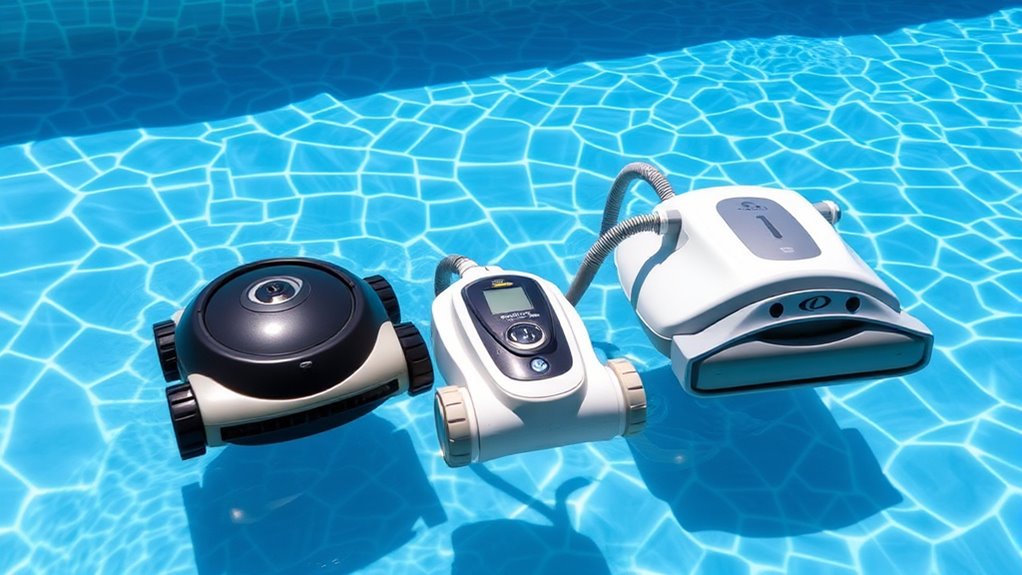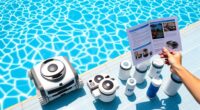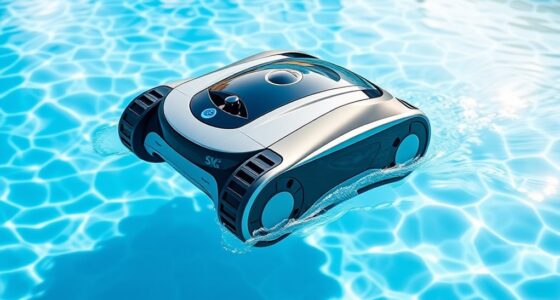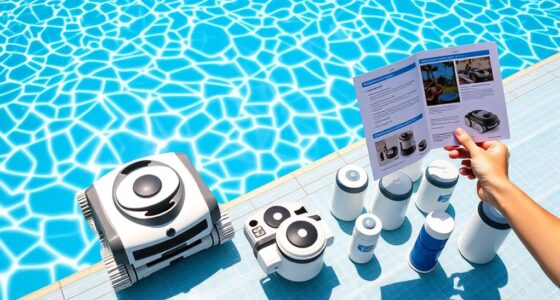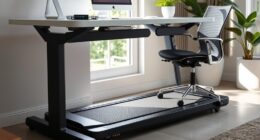If you’re new to automatic pool cleaners, you’ll find three main types: robotic cleaners, pressure side, and suction side models. Robotic cleaners are independent and energy-efficient, while pressure side cleaners rely on your pool’s pressure system and handle larger debris. Suction side models attach directly to your skimmer for easy maintenance. Whether you have an in-ground or above-ground pool affects your choice. Keep exploring to discover how to pick the best for your needs.
Key Takeaways
- Robotic, pressure side, and suction side are the main types of automatic pool cleaners, each with unique features and installation requirements.
- Robotic cleaners operate independently, offering thorough cleaning with minimal user effort, ideal for various pool sizes.
- Pressure side cleaners use water pressure, handle larger debris, and require connection to the pool’s pressure system.
- Suction side cleaners connect to the skimmer or suction line, suitable for routine cleaning and easier to install.
- Consider factors like pool size, energy efficiency, maintenance needs, and budget when choosing the right automatic pool cleaner.
Robotic Pool Cleaners

Have you ever wondered how robotic pool cleaners effortlessly keep your pool spotless? These devices are smartly designed to handle various pool sizes with minimal effort on your part. They adapt to different dimensions, ensuring thorough cleaning whether you have a small plunge pool or a large backyard oasis. One of their key advantages is low power consumption, which means they run efficiently without draining your energy bill. Unlike traditional cleaners that rely on external hoses or pressure systems, robotic cleaners operate independently, using onboard motors and sensors to map and clean surfaces. This combination of suitable power use and adaptability makes robotic pool cleaners an excellent choice for maintaining a pristine pool with ease and efficiency.
Pressure Side Cleaners
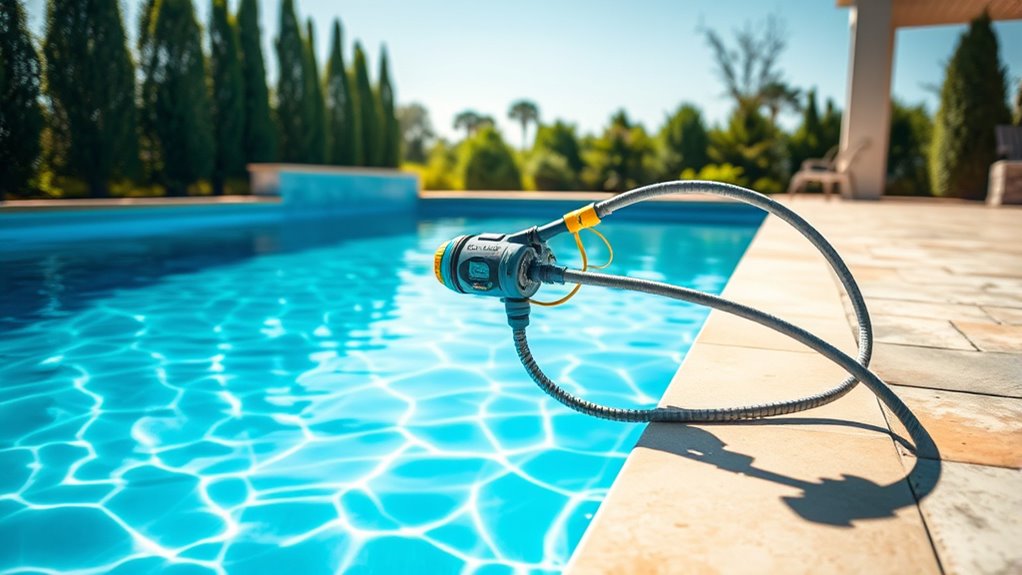
Pressure side cleaners are another popular option for keeping your pool crystal clear. They attach to your pool’s dedicated pressure line and use the water pressure to propel themselves around the pool, collecting debris efficiently. Maintaining proper pool chemical balance is vital to prevent algae and ensure peak cleaner performance. Proper pool maintenance practices can also extend the lifespan of your cleaner and improve overall pool health. Using the correct filter system helps maximize cleaning efficiency and keeps your pool water clear. Additionally, following pool safety tips, like disconnecting the cleaner when not in use, keeps everyone safe. Proper Kia Tuning can also improve overall vehicle handling, which can be useful if you use your car to access different parts of your property for maintenance. Here’s a quick comparison:
| Feature | Pros | Cons |
|---|---|---|
| Power source | Uses existing pressure system | Needs connection to pump |
| Debris capacity | Large, handles bigger debris | Slightly more complex setup |
| Maintenance | Easy to clean filters | Regular filter checks needed |
Pressure side cleaners are effective and easy to operate once installed properly.
Suction Side Cleaners
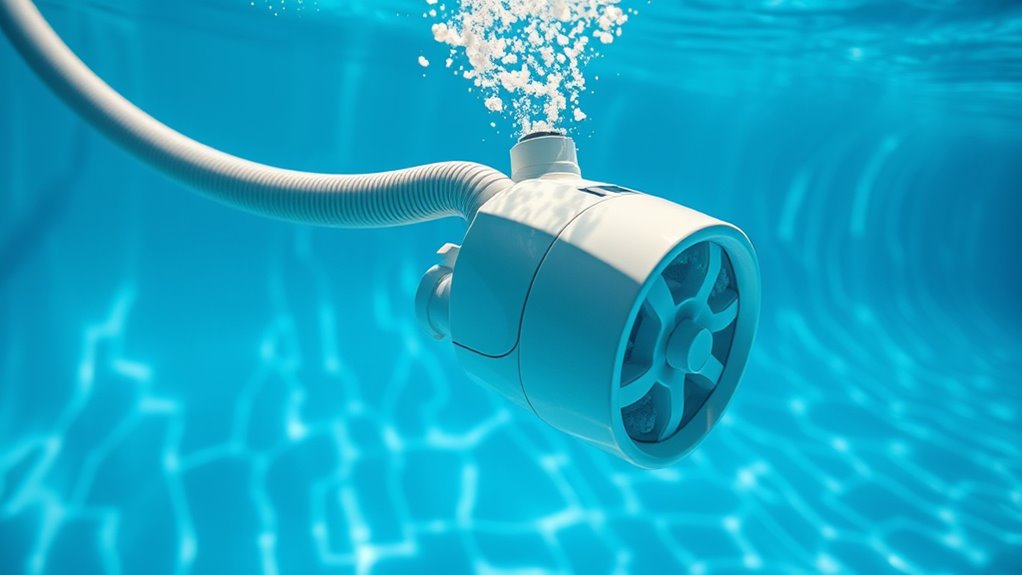
Suction side cleaners are a popular choice for effortless pool maintenance because they connect directly to your pool’s skimmer or dedicated suction line. They work well for various pool sizes, from small to large, providing reliable cleaning without much effort. These cleaners are effective at removing different debris types, including leaves, dirt, and bugs. Their performance depends on your pool’s size and the debris load; larger pools or heavy debris may require more frequent cleaning or a more powerful model. Suction side cleaners are easy to install and operate, making them ideal for routine maintenance. Keep in mind that they rely on your pool’s filtration system, so cleaning or replacing filters regularly ensures optimal performance. Additionally, selecting a compatible model that suits your pool’s specific needs can enhance cleaning efficiency and longevity. Regularly checking and maintaining your pool’s filter system can help prevent clogs and ensure consistent cleaning performance. Proper maintenance of the filtration system can also extend the lifespan of your suction cleaner and improve its cleaning effectiveness. Recognizing signs of system strain can help prevent potential issues and keep your cleaner operating smoothly.
In-Ground vs. Above-Ground Pool Cleaners
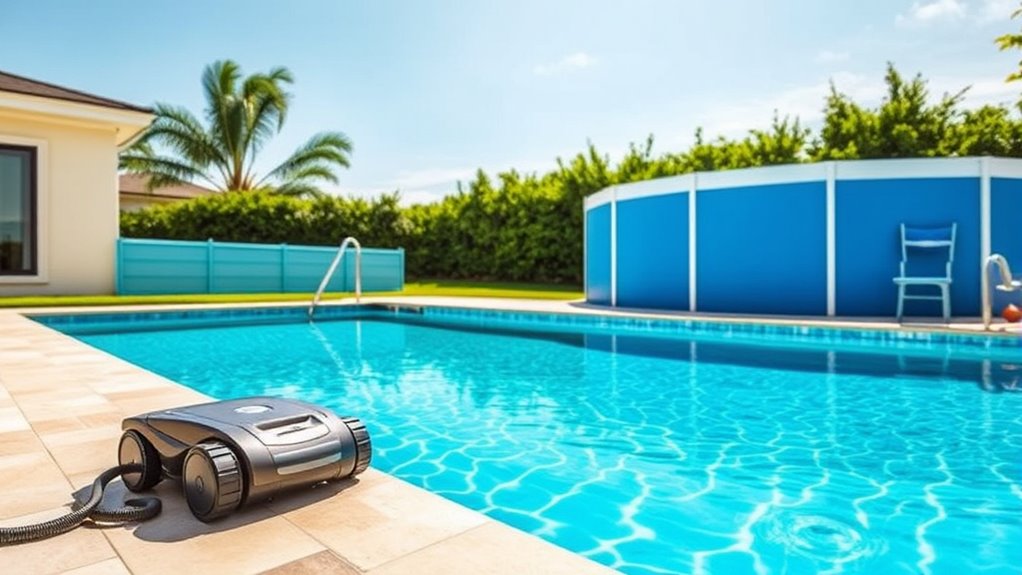
When choosing between in-ground and above-ground pool cleaners, you’ll notice differences in installation requirements and costs. The cleaning coverage area also varies, affecting how thoroughly each cleaner works. Considering maintenance needs and overall expenses helps you pick the best option for your pool. Additionally, understanding the specific beneficial ingredients found in eye patches can help optimize their effectiveness. To select the right cleaner, it can be helpful to understand the types of pool cleaners available and their unique features, including differences in wave and wind effects that can influence cleaning performance in outdoor environments. Recognizing installation complexity and how it impacts long-term maintenance can further aid in making an informed decision, especially since maintenance needs can vary depending on the cleaner type and environmental factors.
Installation Differences
Installing automatic pool cleaners varies considerably between in-ground and above-ground pools, primarily due to their structural differences. In-ground pools typically have a dedicated area on the pool deck for installation, making it easier to set up the cleaner’s power supply and water inlet connections. You may need to run electrical wiring from your power source to the pool area, ensuring safety and compliance with local codes. Above-ground pools often require portable or plug-in models, which connect directly to a standard outlet, simplifying installation. You won’t need extensive electrical wiring or permanent fixtures. Instead, you simply attach the cleaner to the existing hoses and power source. Overall, in-ground pool cleaners demand a more involved setup, while above-ground cleaners offer quick, straightforward installation.
Cleaning Coverage Area
Have you considered how well an automatic pool cleaner can cover your pool’s surface? Your pool size and cleaning frequency influence whether an in-ground or above-ground cleaner is best. In-ground pool cleaners typically offer broader coverage, handling larger pools efficiently, but may be overkill for smaller, above-ground pools. Conversely, above-ground cleaners are designed for smaller spaces, focusing on specific areas with less coverage but adequate for their size. Additionally, selecting a cleaner with the appropriate coverage area ensures effective cleaning tailored to your pool’s dimensions. It is also important to consider the type of system you choose, as it impacts installation and maintenance. To choose the right cleaner:
- Assess your pool size to determine necessary coverage.
- Decide how often you want to clean, as some cleaners are better suited for frequent or occasional use.
- Match the cleaner’s coverage area with your pool’s dimensions for ideal results.
Cost and Maintenance
Choosing the right automatic pool cleaner involves more than just coverage; cost and maintenance play a significant role in your decision. In-ground pool cleaners tend to have higher upfront costs but often offer better energy efficiency, which can reduce long-term costs. They typically require less frequent maintenance and are built to last, making them more economical over time. Additionally, in-ground models often feature advanced filtering systems that enhance cleaning performance and reduce the need for manual intervention, ultimately saving you time and effort. Properly assessing filtering system efficiency can help you determine which model will perform best for your specific pool conditions. Regularly inspecting and cleaning the filtering system is essential to maintain optimal performance. Investing in energy-efficient models can further lower operating expenses and improve overall cost-effectiveness. Above-ground cleaners usually cost less initially but might have higher energy consumption and more frequent repairs, increasing overall expenses. Consider how often you’ll need maintenance and the energy efficiency of each option. Understanding the maintenance requirements of each type helps ensure you choose a cleaner that fits your lifestyle and budget. Ultimately, weighing initial costs against ongoing maintenance and energy use helps you choose the most cost-effective cleaner for your pool.
Features to Consider When Choosing
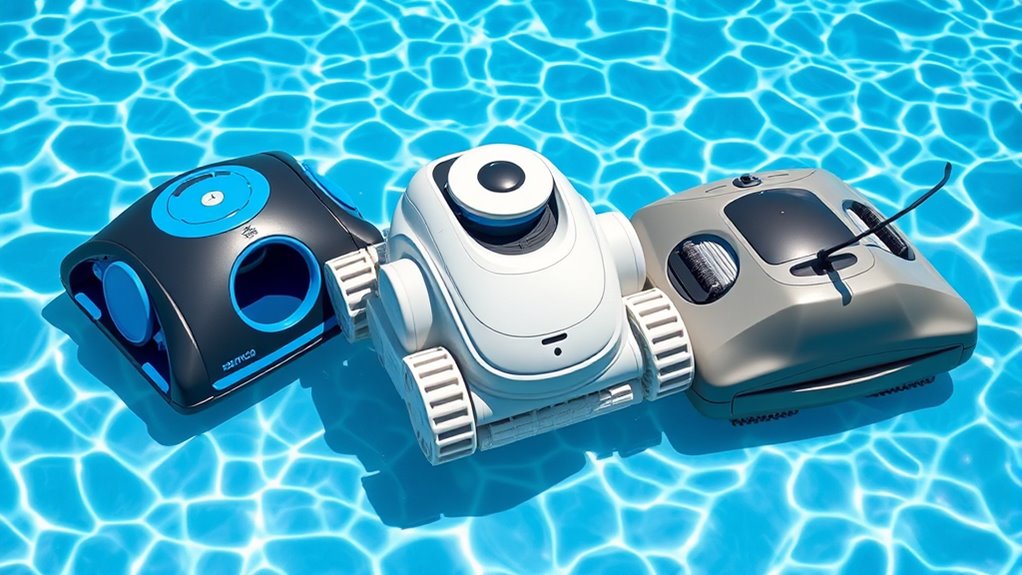
When selecting an automatic pool cleaner, focusing on key features can make a significant difference in your experience. Consider these aspects:
- Energy efficiency – A model with low power consumption saves you money and reduces environmental impact. Energy-efficient operation can also help prolong the lifespan of your equipment and reduce maintenance costs.
- Noise levels – Choose a cleaner that operates quietly so it doesn’t disturb your peace or outdoor activities. Lower noise levels contribute to a more relaxing swimming environment and less disturbance to nearby neighbors.
- Cleaning coverage – Ensure it covers the entire pool, including corners and steps, for thorough cleaning. Proper coverage is essential for maintaining water quality and reducing the need for manual cleaning.
- Performance tuning knowledge can help optimize the cleaner’s operation for better results. Performance tuning can be applied to enhance the efficiency and lifespan of your pool cleaner, ensuring it operates at peak performance.
Tips for Maintaining Your Pool Cleaner

To keep your pool cleaner working effectively, you should regularly clean the filter baskets and remove any debris. Checking for obstructions in the brushes and hoses helps prevent malfunctions. Staying on top of these simple tasks ensures your cleaner operates smoothly. Additionally, inspecting the type of churn used in your pool’s filtration system can help identify potential issues before they affect performance. Regularly monitoring water quality can also extend the lifespan of your pool equipment and improve overall efficiency. Understanding how self watering plant pots maintain consistent moisture levels can provide insights into effective water management, which can be useful for maintaining clean and healthy pool water. Furthermore, understanding how indoor air quality impacts health can help you maintain a safer environment around your pool area.
Regularly Clean Filter Baskets
Regularly cleaning your pool cleaner’s filter baskets is essential for maintaining peak performance. A clean filter basket guarantees effective debris removal and prevents clogs that can hinder your cleaner’s operation. To keep it in top shape, follow these steps:
- Remove the filter basket carefully, avoiding damage.
- Empty out debris buildup and rinse it thoroughly with water.
- Check for any tears or damage, replacing if necessary.
Check for Obstructions
After cleaning your filter baskets, it’s a good idea to inspect your pool cleaner for any obstructions. Check around the pool cover area for leaves or debris that might have fallen into the cleaner’s path. Confirm the water level is adequate, as too low a level can cause the cleaner to lose suction or get stuck. Look for tangled hoses or brushes that may have caught on debris or the pool’s edges. Obstructions can hinder movement and cleaning efficiency, so clear any debris or obstacles you find. Also, verify that the water flow isn’t blocked, which can impact the cleaner’s performance. Regularly checking for obstructions helps keep your pool cleaner running smoothly and prolongs its lifespan.
Frequently Asked Questions
How Long Do Automatic Pool Cleaners Typically Last?
Automatic pool cleaners usually last between 5 to 10 years, depending on how well you maintain your pool and follow your cleaning schedules. Regular pool maintenance, such as cleaning filters and checking for wear, can extend their lifespan. Proper use and timely repairs prevent premature breakdowns, ensuring your cleaner stays effective longer. Keep up with routine care, and you’ll maximize its longevity, making your investment worthwhile over the years.
Are Robotic Pool Cleaners Energy-Efficient?
Robotic pool cleaners are energy-efficient, using less power compared to traditional suction or pressure cleaners. Their energy consumption is typically low, which helps save on electricity bills. You’ll find that maintenance frequency is minimal, as these devices are designed for durability and easy upkeep. By choosing a robotic cleaner, you benefit from efficient cleaning while keeping energy costs and maintenance efforts manageable.
Can Pool Cleaners Handle Large Debris?
Ever wonder if your pool cleaner can handle those stubborn leaves and debris? Many models struggle with large debris and high leaf accumulation, but some have impressive debris capacity and stronger suction power. You should choose a cleaner designed for big messes, especially if your yard tends to produce lots of leaves. Don’t settle for less—opt for a model that tackles large debris efficiently, saving you time and effort.
How Often Should I Replace Pool Cleaner Parts?
You should replace pool cleaner parts based on your maintenance schedules and part compatibility. Typically, check your cleaner every few months, and replace brushes, hoses, or filters as needed—usually every 6 to 12 months. Regularly inspecting parts guarantees peak performance and longevity. Follow manufacturer recommendations and keep spare parts on hand to avoid downtime. Proper maintenance helps your pool cleaner work effectively and extends its lifespan.
Are There Eco-Friendly Pool Cleaner Options Available?
Sure, eco-friendly options like solar-powered cleaners sound great—until you realize they might just be a fancy way to keep the sun paying your electric bill. Still, these eco-friendly options exist, and solar-powered cleaners are a fantastic choice if you want to reduce your carbon footprint. So, go ahead, embrace greener technology, and enjoy a clean pool without feeling guilty every time you flip the switch.
Conclusion
So, after all this, you might think choosing the right pool cleaner is straightforward. But with so many options and features, it’s almost like mastering a secret art. Ironically, the more you learn, the more you realize how little you really understand. Still, you’ll probably end up with the perfect cleaner, only to discover it’s just as much of a mystery as keeping your pool spotless—yet somehow, that’s part of the fun.
